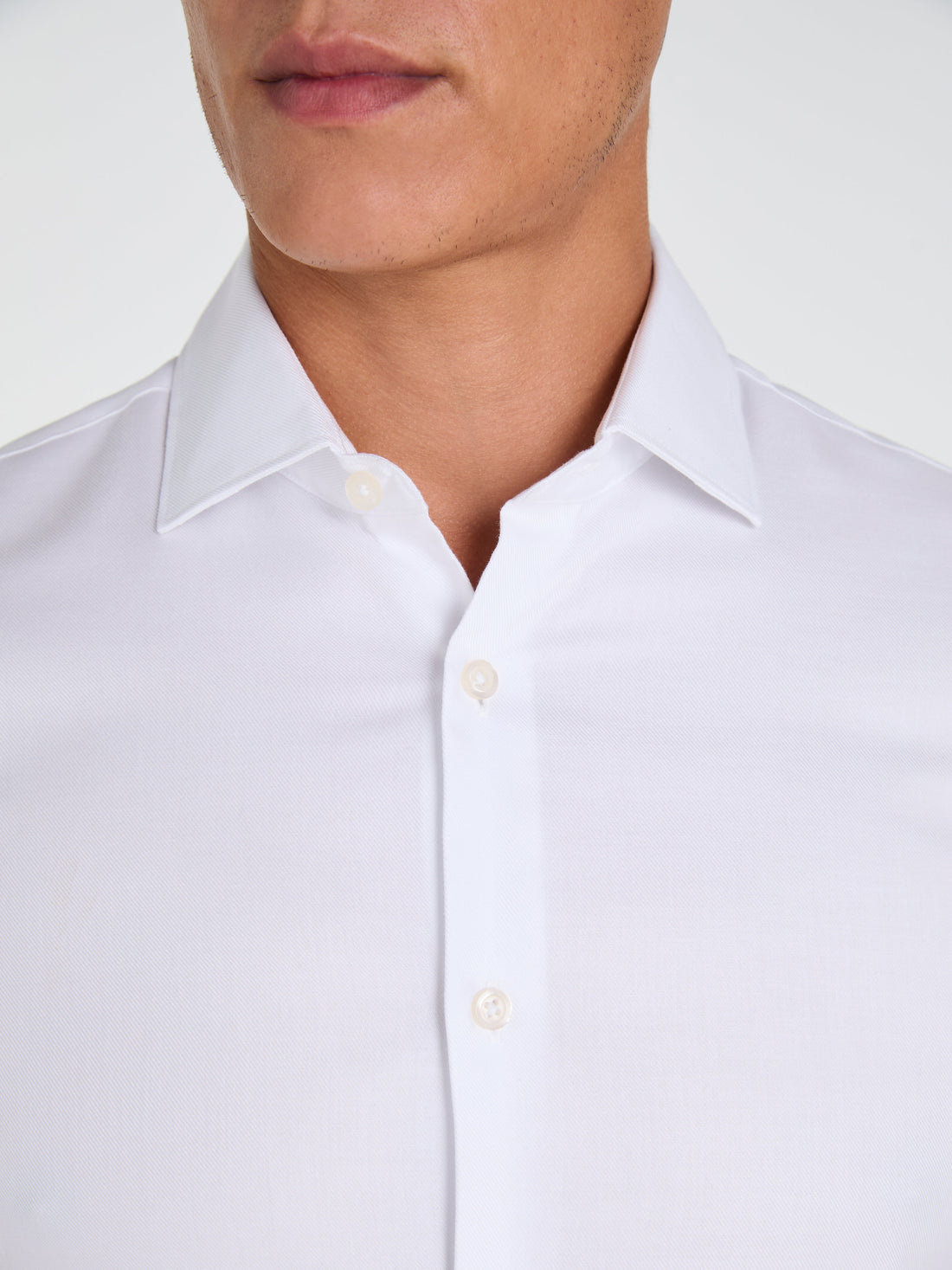
The Shirt Collar Guide
1. Why Collars Matter
The collar is the first thing people notice above the jacket line. Get it right, and it sharpens everything, from your jawline to your overall proportion. Get it wrong, and even the finest suit can look slightly off.
The perfect collar works in harmony with your suit, your tie, and your face shape. It’s the anchor of understated tailoring.

2. The Main Types of Shirt Collars
Let’s break down the most popular collar styles, what they say about you, and when to wear them.
The Classic (Point) Collar
Classic. Understated. Always appropriate.
With a narrow spread between the points, this is the most traditional and universally flattering collar style. It’s designed to elongate the face, making it ideal for men with rounder or wider facial features.
Best for: Everyday business wear and formal occasions.
Pairs with: Slim ties and simple knots (four-in-hand works best).
Style note: A true essential, if you own one collar style, make it this.
Want to learn more? Read our Ultimate Shirt & Formalwear Guide
The Semi-Cutaway Collar
Modern and balanced. The all-rounder.
Sitting between a classic and a cutaway, the semi-cutaway collar offers versatility for both formal and semi-formal settings. It complements a wide range of tie knots and suit lapels.
Best for: Business and professional settings.
Pairs with: Half-Windsor or Windsor tie knots.
Style note: A favourite among contemporary professionals, it's sharp without shouting.
The Cutaway Collar
Confident. Contemporary. Distinctive.
With its wide angle and outward-pointing tips, the cutaway collar was designed to frame a substantial tie knot, but looks equally sophisticated open-necked. It’s a bold yet elegant statement.
Best for: Dressy business and formal occasions.
Pairs with: Windsor knot, or no tie for a relaxed-but-polished look.
Style note: Best suited to longer or narrower faces, it balances proportions beautifully.
The Button-Down Collar
Relaxed refinement. Understated elegance.
Originally created for polo players in the late 19th century, the button-down collar remains a staple of smart-casual style. Its small buttons keep the points neatly anchored, lending a relaxed structure that pairs well with knitwear or unstructured blazers.
Best for: Business casual, weekend wear, or travel.
Pairs with: Casual suits or layered looks. Usually worn without a tie.
Style note: An American Ivy League icon; smart but never stuffy.
Read our Business Casual vs Smart Casual guide to learn the differences in the two styles.
The Wing Collar
Pure formality. Reserved for eveningwear.
Short, stand-up points “wing out” from the neck, designed specifically for black-tie or white-tie dress codes. Traditionally worn with a bow tie and tuxedo shirt, it’s the collar equivalent of a Rolls-Royce: classic, refined, and unapologetically formal.
Best for: Black tie, white tie, or ceremonial events.
Pairs with: Bow tie only. Never a necktie.
Style note: The finishing touch to a true formal ensemble.
Read our Black Tie guide for more detail.

3. Matching Collars to Face Shapes
A simple rule of thumb: contrast your features.
| Face Shape | Best Collar Type | Why It Works |
|---|---|---|
| Round | Classic or Semi-Cutaway | Sharpens and elongates the face. |
| Square / Strong Jawline | Cutaway or Semi-Cutaway | Balances width with open lines. |
| Oval / Balanced | Any | Proportional, suits most collar types. |
| Long / Narrow | Cutaway or Button-Down | Adds visual width and balance. |
Small tweaks make big differences, and the right collar can subtly redefine your whole look.
4. Ties, Knots & Collars: The Right Pairings
Your collar dictates which tie knot will sit best.
| Collar Type | Recommended Knot | Notes |
|---|---|---|
| Classic | Four-in-Hand | Neat, understated, asymmetrical. |
| Semi-Cutaway | Half-Windsor | Balanced and professional. |
| Cutaway | Full Windsor | Wide knot fills the open collar space. |
| Button-Down | None / Four-in-Hand | Best left tieless, or with soft-knit ties. |
| Wing | Bow Tie | Strictly eveningwear only. |
Related reading: learn how to Tie a Tie
5. Collar Stays & Structure
The difference between a sharp collar and a tired one often comes down to structure.
Collar stays, the small inserts in the underside of the collar, keep collars crisp and flat. Remove them before washing, reinsert after ironing, and replace plastic ones with metal for long-term use.
Soft vs Structured:
-
Structured collars hold shape throughout the day. Ideal for formal shirts.
-
Soft collars relax the silhouette. Perfect for smart-casual looks.
Read more about different shirt fabrics.
6. How to Choose the Right Collar for Your Wardrobe
Think of collars as the language of dress codes. Each speaks differently:
| Setting | Recommended Collars | Why |
|---|---|---|
| Formal (Suits & Ties) | Classic or Cutaway | Polished and versatile. |
| Smart-Casual / Hybrid Work | Button-Down | Relaxed yet refined. |
| Evening / Black Tie | Wing | The only correct choice for tuxedos. |
| Everyday Office | Semi-Cutaway | Professional without fuss. |
A well-curated wardrobe includes a mix; from the daily workhorse to the occasional statement piece.

7. In Closing
A great collar should never steal attention, it should frame it. It’s the detail that separates the competent dresser from the considered one.
Whether you prefer the timeless neatness of a classic collar or the bold sweep of a cutaway, understanding your collar is understanding your style.
At T.M. Lewin, every collar is designed with purpose; engineered for proportion, comfort, and the quiet confidence that defines true craftsmanship.
Because in menswear, it’s not just what you wear, it’s how it fits, frames, and finishes the look.
Shop the Shirt collection today